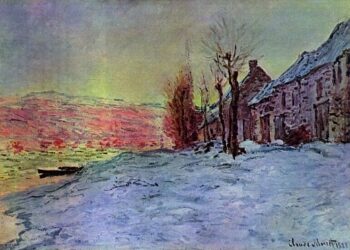Table of Contents
ToggleIntroduction
Between Walls Summary & Themes By William Carlos Williams A key character in American modernist poetry, William Carlos Williams is well-known for his attention to the small elements of daily life, everyday language, and accurate imagery. Williams examines themes of survival, the futility of human striving in the vast scheme of nature, and the tenacity of life in his poem Between Walls.
The poem’s understated manner and astute observations of a minor, seemingly unimportant incident are hallmarks of Williams’ writing. Williams explores universal themes of life, death, and the resilience of nature in the face of human interference with this straightforward yet dramatic illustration of a little plant growing between wall cracks.
Although Between Walls is a brief poem, its conciseness conceals a more in-depth examination of life’s intricacies. Although the picture Williams depicts—a plant sprouting in an unexpected location—seems depressing, the poem challenges readers to consider how resilient life can be when faced with hardship. The poem raises important issues on the interrelationship between life and the structures that humans build, all while focusing on a tiny but tenacious aspect of the natural world and using simple language.
Summary of Between Walls by William Carlos Williams
William Carlos Williams’ brief, striking poem “Between Walls” depicts a moment of life flourishing in an otherwise dead setting. The poem, which is one stanza long, depicts a situation where a tiny plant thrives among rubble and garbage in a wall’s crevices. In this situation, the plant’s survival serves as a potent metaphor for tenacity and perseverance.
The poem begins with a description of the wall, a lifeless, bleak, grey construction. It is more than just a wall; it is a symbolic division between the natural and the constructed worlds, between life and death. But in spite of the intimidating aspect of the wall, a little, colorful plant finds a way to grow in a crevice that most people are unaware of. Williams makes it apparent that the plant is struggling to survive under the most hostile conditions rather than thriving in a perfect setting. Its survival is a veritable marvel, demonstrating nature’s ability to endure even in the most improbable circumstances.
Williams concentrates on the contrast between the plant and the surrounding detritus in the poem’s second half. The “rotting wood” and “broken stone” symbolize the neglect and deterioration that permeate the area surrounding the factory. The plant is still alive, though, and provides a silent symbol of hope in a world full of devastation and death. It is tiny, delicate, and a reminder that life may persevere even in the face of adversity.
Read more
Despite the poem’s straightforward wording, the imagery is full with meaning. A reminder that life, no matter how delicate, can nevertheless flourish in the most improbable situations is provided by the plant’s ability to flourish in an unfriendly environment. This idea of resistance is furthered by the poem’s simple language, which turns what might otherwise seem like a pointless or even hopeless circumstance into a representation of life’s tenacity.
The poem also raises the pointlessness of human striving at the same time. The wall, the rubble, and the deterioration stand in for human attempts to build long-lasting structures, yet nature is still the ultimate source of life. The tiny plant’s ability to survive is a subliminal statement about the limits of human might and the tenacity of nature. Williams offers an insight into the transience of both human existence and man-made structures by delicately contrasting human creations with the eternal power of nature.

Themes in Between Walls by William Carlos Williams
1. The Persistence of Life:
Between Walls Summary & Themes By William Carlos Williams Perseverance in the face of great misfortune is one of Between Walls’ most prominent themes. The ability of life to persist in the face of seemingly insurmountable challenges is symbolized by the plant that grows between the walls. It represents the silent yet potent resistance of the natural world to the forces of neglect, deterioration, and destruction. The plant thrives despite its unfavorable surroundings, demonstrating that life can persist even in the most improbable and hostile settings.
Williams illustrates the idea that life is robust and tenacious by using this modest yet strong image. This tenacity is celebrated by the plant’s growth in spite of all obstacles. This topic of surviving in a harsh environment can be metaphorically applied to human existence, implying that optimism and tenacity can endure even in the face of adversity.Between Walls Summary & Themes By William Carlos Williams
2. Nature vs. Human Constructs:
Between Walls Summary & Themes By William Carlos Williams The conflict between man-made structures and nature is another important element in the poem. The wall is a human-made object that symbolizes the artificial, regulated, and ordered world that humans have created.
Additionally, the debris represents human activity and its detrimental effects on the environment. The attempt by humans to control or govern nature is subtly criticized by the plant that grows in the spaces between the walls. Nature maintains its presence despite human constructions like fences and buildings, unaffected by human designs.
This topic also emphasizes how fleeting human accomplishments are. In the end, nature—represented by the plant—is more resilient than the wall, which appears solid and permanent. The fact that the plant can survive in the crevices of man-made items despite its fragility and small size suggests that nature is more resilient than man-made constructions. In this way, the poem draws a contrast between the transient character of human inventions and the timeless, subdued power of nature.
3. Mortality and Impermanence:
The poem’s theme of mortality is delicately interwoven throughout. The rotting wood and broken stone that surround the plant indicate that everything, including man-made structures, is prone to death and decay. However, the plant is flourishing rather than only surviving.
Between Walls Summary & Themes By William Carlos Williams Its development in such a barren setting implies that life—even in its most delicate forms—will endure in spite of the devastation and decay all around it. Although everything is susceptible to the effects of time, there is always hope for rebirth and development, as this contrast between life and death reminds us.
Read more
4. Fragility and Strength:
The plant’s diminutive size and fragility stand in stark contrast to its ability to survive. Its survival is precarious, yet it is also powerful enough to penetrate the wall’s toughened, seemingly indestructible structure. The poem’s main theme is the conflict between strength and frailty. Even though it is delicate, life can persevere in the face of overwhelming adversity. The plant’s ability to thrive in the crevices serves as a metaphor for human tenacity, implying that growth and survival are possible even in the face of adversity.
Williams makes advantage of this contrast to elicit a more profound comprehension of the human condition: life is limited and delicate, but survival has an innate strength. Between Walls Summary & Themes By William Carlos Williams
5. The Beauty of the Everyday:
Between Walls highlights the beauty of the commonplace, which is consistent with Williams’ modernist style. The poem transforms a commonplace scene—a little plant growing between wall cracks—into something profound and significant. Williams’ greater body of work, which frequently finds beauty in the most mundane aspects of life, is characterized by its emphasis on the everyday. The poem thus honors the little, frequently overlooked moments that comprise human life.
Williams implies that there is beauty and significance to be found even in the smallest and most commonplace situations by concentrating on an apparently inconsequential plant. This theme encourages readers to recognize the small, commonplace joys of life that are frequently overlooked in the clamor of bigger, more spectacular occasions.Between Walls Summary & Themes By William Carlos Williams

Conclusion
Between Walls Summary & Themes By William Carlos Williams Between Walls by William Carlos Williams is a potent reflection on life, surviving, and the natural environment. The poem examines themes of resiliency, death, and the difference between man-made structures and the timeless power of nature through the straightforward yet deep picture of a plant growing between wall cracks.
Williams’ emphasis on daily living and simple approach encourage readers to see the value and beauty of the little, silent moments that comprise our lives. The plant’s continued existence is a moving representation of rebirth, hope, and the ability of life to endure even in the most hostile conditions.Between Walls Summary & Themes By William Carlos Williams
Read more
FAQ
Q1: What is the significance of the wall in the poem?
The wall in Between Walls symbolizes human constructs—structures built to dominate or separate the natural world. It represents the artificial boundaries that humans create in their attempts to control or shape their environment. However, the wall also becomes a metaphor for the decay of human endeavors, as the plant manages to grow despite the barrier. The wall suggests both the temporary nature of human efforts and the resilience of nature in overcoming obstacles.
Q2: How does the plant symbolize resilience?
The plant in the poem is a symbol of resilience because it survives and grows in an unlikely and harsh environment. Despite the surrounding decay and the physical barrier of the wall, the plant continues to thrive, symbolizing life’s persistence and ability to endure adversity. The plant’s existence reflects the idea that, no matter how fragile life may seem, it can still find a way to survive and grow.
Q3: What does the poem suggest about the relationship between nature and human activity?
The poem suggests that while human activity, represented by the wall and debris, may seem to control or dominate the natural world, nature will always find a way to persist. The plant’s growth in the cracks of the wall shows that nature is not easily contained or defeated. This dynamic highlights the tension between human constructs and the power of nature, with the latter ultimately proving more enduring.
Q4: How does Williams use imagery to convey the theme of mortality?
Williams uses the imagery of decaying debris—broken stone and rotting wood—to symbolize mortality and impermanence. These images evoke the idea that everything, including human-made structures, eventually succumbs to time and decay. The plant, however, growing amidst this decay, offers a glimmer of hope and renewal, suggesting that while death and decay are inevitable, life can still emerge from the rubble.
Q5: What is the significance of the poem’s brevity?
The brevity of Between Walls enhances the power of its message. In just a few lines, Williams captures a moment of life, fragility, and survival, forcing the reader to pay attention to the quiet, often overlooked moments of existence. The poem’s minimalist approach reflects the modernist ethos of finding meaning in the simplest, most mundane aspects of life.

















